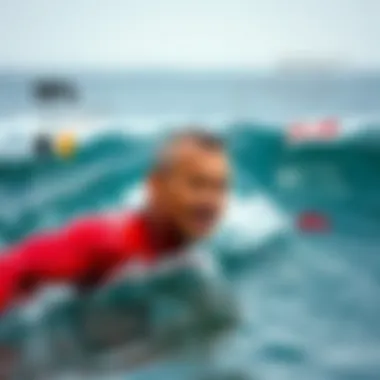Recognizing Dehydration: Key Signs and Tips


Intro
Dehydration isn't just a thirst issue; it's a serious condition that can sneak up on anyone, especially those who spend time in sun-soaked environments like surfers. Recognizing the signs and symptoms of dehydration can be life-saving, allowing you to take action before it spirals into something more severe.
Every beachgoer knows that feeling of heat bearing down on them as they paddle out, but how many can pinpoint the early signs of dehydration? When you’re riding the waves, you may not think about hydration, yet it's crucial for your performance and well-being.
In the following sections, we’ll unpack the various indicators of dehydration, how to assess your hydration levels effectively, and, most importantly, strategies to stay hydrated in the ever-challenging conditions of the surf.
Awareness is key, especially for people engaged in physically demanding activities. Let’s dive into a clearer understanding of what dehydration looks like, and how to combat it.
Understanding Dehydration
Grasping the concept of dehydration is crucial for anyone who cares about their health, especially for those engaging in physical activities like surfing or any outdoor endeavor. The significance of understanding this topic cannot be overstated. Dehydration is not merely about feeling thirsty; it can lead to severe health complications if not recognized and managed correctly.
When we talk about dehydration, we're addressing a state where the body loses more fluids than it takes in. This can disrupt bodily functions and lead to symptoms that range from minor discomfort to potentially life-threatening situations.
Definition of Dehydration
Dehydration occurs when your body does not have enough fluids to function properly. It can result from various factors, including inadequate intake of fluids, excessive loss of fluids through sweating, vomiting, diarrhea, and more. In essence, when fluid loss exceeds fluid intake, it results in a dehydrated state.
Causes of Dehydration
Dehydration can arise from several sources that often overlap, affecting hydration levels significantly. Understanding these causes is vital for prevention and effective response.
Environmental factors
Environmental conditions can play a substantial role in hydration status. For example, hot and dry climates can increase perspiration and fluid loss without the person realizing it. It's a sneaky thief; you sweat, but may not feel thirsty right away. This delayed thirst response means more awareness of hydration strategies is necessary in such environments. The key characteristic of environmental factors is their variability, which can catch even the most seasoned surfer off guard. Moreover, conditions such as high altitude can lead to higher fluid loss due to increased respiration rates and temperature regulation needs.
Physical activity
Physical activity, especially vigorous pursuits, can significantly accelerate dehydration. Whether you're catching waves or hiking up a steep incline, the body's metabolic rate increases, leading to enhanced perspiration. The unique feature here is the difference between casual and intense physical engagements. Casual strolls in milder conditions might not lead to immediate dehydration, but a long surf session under the sun will. Therefore, athletes need to be proactive, ensuring they're hydrating before feeling thirsty. The downside is that intense activity often comes with a reduced sense of fatigue, which may lead individuals to overlook their hydration needs.
Illness or medical conditions
Certain illnesses or medical conditions can exacerbate dehydration risks as well. For instance, fever can induce sweating, while illnesses causing vomiting or diarrhea can lead to rapid fluid loss. Those with chronic conditions like diabetes or kidney disease may find themselves at greater risk due to their body's fluid management issues. The characteristic here is responsiveness; individuals must adjust their fluid intake based on their health status. Unfortunately, not everyone is inclined to monitor their hydration when unwell, thus making them vulnerable to dehydration.
In summary, being aware of the definition, causes, and specific contexts related to dehydration is imperative for maintaining optimal hydration levels. This knowledge is especially vital for individuals active in demanding environments, where fluid balance can make or break performance and overall health.
Recognizing Early Signs of Dehydration
Understanding the early signs of dehydration is crucial, especially for those engaged in physically demanding activities like surfing or other sports. Recognizing these signs can lead to timely intervention, preventing further complications. Ignoring early symptoms may result in severe health issues, as dehydration can escalate quickly under strenuous conditions. Thus, being mindful of how our body communicates its needs is important. This section covers critical physical symptoms along with behavioral changes that indicate the onset of dehydration.
Physical Symptoms
Thirst
Thirst is often the first indication that your body is on the brink of dehydration. It serves as a natural alarm bell, signaling that your fluid levels are diminishing. This sensation is hardwired into our biology but can also be influenced by environmental factors like heat or humidity.
A notable characteristic of thirst is its immediacy; it strikes without delay as the body recognizes a deficit in fluids. However, thirst should not be the only guide for hydration. Relying solely on thirst can be misleading, particularly for those engaged in rigorous activities where fluid loss may be significant. One downside is that by the time thirst is felt, the body may already be partially dehydrated. Thus, it’s beneficial to maintain a proactive approach to hydration even when not feeling thirsty.
Dry Mouth and Lips
Another crucial sign is a dry mouth and cracked lips. This particular symptom can be particularly distressing and is often missed. A dry oral cavity can lead to difficulty in swallowing and speaking, impacting daily life significantly.
The unique feature of this symptom is its conspicuousness; it is hard to overlook the discomfort that comes with dry lips and mouth. For surfers and athletes, it can hinder performance as moisture is vital for many bodily functions. However, it does have a drawback. It might not appear until dehydration levels have reached a concerning degree. Therefore, recognizing this early can save you from further complications.
Fatigue
Feeling overly tired or fatigued is yet another red flag. Fatigue due to dehydration can manifest as a general sense of tiredness or an unexpected lack of energy, which can result in reduced performance. People often dismiss fatigue as a normal part of their active lifestyle, which can be a dangerous oversight.
This symptom's critical characteristic is its all-encompassing nature; it's not isolated to physical fatigue but can also affect mental stamina. Unlike thirst or dry mouth, fatigue might not always trigger an immediate response for hydration. Instead, it can lead to a vicious cycle, where exhaustion results in inadequate hydration and vice versa. For athletes, this can significantly impact their performance over time, causing a chain reaction of health issues.
Behavioral Changes
Irritability
Dehydration doesn’t just affect you physically; it can also take a toll on your mental well-being. Irritability is often an overlooked sign that hydration levels are dipped. When the body is dehydrated, it struggles to maintain cognitive functions and mood balance.
This symptom is characterized by its sudden onset; you might find yourself being snappish or more irritable than usual, even over trivial issues. The unique aspect of irritability is that it affects not just the individual but also their interactions with others, which can lead to conflicts in group settings like surfing teams. Noticing irritability could serve as a wake-up call to rehydrate before it escalates into something more troubling.
Concentration Difficulties
Struggling to focus? It could be a sign of dehydration. Concentration difficulties can hinder performance in all areas, from work to sports. This symptom can manifest as foggy thinking or an inability to maintain attention on tasks, directly decreasing your efficiency.


The key characteristic of this issue is its impact not only on physical tasks but also on cognitive functions, making it a multifaceted problem. As hydration diminishes, mental agility falters. This can be particularly concerning for surfers who require sharp focus for their safety and performance.
Reduced Alertness
Reduced alertness is a more advanced stage of dehydration that we need to recognize. This can show through slower reaction times and decreased general awareness of your surroundings, making it tremendously dangerous, especially for athletes. The unique feature here is that reduced alertness can compromise safety, particularly in water sports where the environment can change in an instant.
It’s easy to overlook this symptom until it becomes pronounced, making it crucial to remain vigilant of subtle shifts in alertness levels. While coping with fatigue or irritability, reducing alertness can significantly increase the risks of accidents and injury.
Recognizing these early signs will empower individuals to act promptly, promoting hydration to restore balance and maintain peak performance.
Severe Dehydration: Indicators to Watch For
Understanding the signs of severe dehydration is crucial, especially for those engaged in high-energy activities such as surfing or any outdoor sports. When fluid loss becomes critical, it can lead to serious health consequences. Recognizing these indicators early ensures one can seek timely medical intervention, preventing further health issues.
Critical Physical Symptoms
Rapid heartbeat
Rapid heartbeat can often serve as an early warning sign of severe dehydration. As body fluids dwindle, the heart compensates by working harder to maintain blood flow. This results in an elevated heart rate known as tachycardia. One must monitor this symptom closely; a significant increase in heart rate can indicate the body is under stress and not receiving adequate hydration.
It's important to understand that a rapid heartbeat can occur even when an individual feels fine, thus highlighting the need for constant self-assessment. If you're an athlete, recognizing your body's signals can determine performance and safety.
Confusion
Another concerning sign of intense dehydration is confusion. As the body becomes critically low on fluids, vital organs, including the brain, fail to function optimally. This can lead to disorientation, difficulty in focusing, and impaired decision-making processes. It's vital for anyone, particularly those involved in physically demanding activities, to stay aware of this symptom. Being confused isn't just disconcerting; it can lead to poor choices regarding hydration or activity levels, worsening the situation.
Severe weakness
Severe weakness is perhaps one of the most alarming symptoms associated with dehydration. It feels like your body is dragging along, and it’s challenging to complete even basic tasks. This weakness arises because dehydration affects muscle function and overall energy levels. A key characteristic of severe weakness is the feeling of fatigue that doesn't dissipate with rest. In such cases, the body may struggle to recover without proper hydration, making it critical for individuals to not just recognize but also address early signs of weakness to avoid severe repercussions.
Signs in Children and Infants
Decreased urine output
One of the most telling signs of dehydration, especially in children and infants, is decreased urine output. Normally, children urinate regularly, and a sudden drop can suggest that their body is holding onto fluids in response to dehydration. Parents and caregivers should watch for this symptom closely. Not producing enough urine can lead to severe dehydration outcomes, making it imperative to act swiftly if this indicator presents itself.
Sunken eyes
Sunken eyes are another visible sign that may indicate a child is dehydrated. When a child’s hydration levels drop, it often reflects in their facial features. The eyes may appear more prominent, creating a hollow appearance. This isn’t just a cosmetic concern; it’s an alarming sign that their body is in distress and needs rehydration urgently. Recognizing such changes can help one take proactive steps to ensure that children remain hydrated during hot days or after bouts of illness.
Dry skin
Dry skin is a visible symptom associated with dehydration in both children and adults. When the skin loses elasticity and appears rough, it indicates insufficient moisture in the body. For children, this can lead to discomfort and increased susceptibility to skin irritations. Caregivers should pay careful attention to changes in skin texture, as it serves as an external indicator of internal hydration levels. Keeping the skin hydrated is essential for maintaining overall health, especially in high-activity environments.
In summary, recognizing signs of severe dehydration can drastically alter outcomes, particularly in younger individuals or those engaged in strenuous activities. Awareness and prompt action can prevent serious health complications.
Assessing Hydration Status
Understanding the hydration status is essential, especially given its impact on physical performance and overall well-being. It's not just about drinking water; it’s about knowing how to gauge whether your body is properly hydrated. Recognizing this status empowers individuals, particularly athletes and those engaged in physically demanding activities, to make informed choices regarding their fluid intake.
Urine Color Indicator
Pale yellow to clear
A pale yellow to clear urine color is generally a clear sign of good hydration. This shade indicates that the body's fluid levels are adequately replenished, primarily reflecting a balance between water intake and loss. Maintaining this level signals that a person is proactive in their hydration habits, which is crucial for anyone, particularly surfers or athletes, who demand a lot from their bodies.
This color range is not only straightforward but also accessible. You don’t need fancy equipment—just a glance at your urine can reveal a lot. It's a practical, easy way to monitor hydration and adjust fluid intake accordingly. In fact, many hydration apps or trackers use urine color as a simple guideline, making it popular among those engaged in rigorous physical activity.
Advantages of Pale Yellow to Clear
- Simplicity: Easily recognizable and doesn't require medical knowledge.
- Real-Time Feedback: Immediate way to adjust hydration without any invasive techniques.
Darker shades and their implications
On the flip side, urine that appears darker, especially amber or brown, is a warning sign. These shades typically indicate dehydration, showcasing that the body is losing more fluid than it's taking in. Recognizing this can be crucial, especially in hot weather or during intense physical activity when fluid loss occurs at a higher rate.
With darker shades, it becomes imperative to reassess one’s hydration habits immediately. This is the body's way of signaling that it's time to gulp down more water or consume hydrating foods. An added layer is that different factors, like diet and medications, can influence urine color, making awareness key in discerning hydration status.
Unique Features of Darker Shades
- Critical Indicator: Serves as a powerful prompt to address hydration lacking.
- Behavior Adjustment: Highlights the need for immediate changes in fluid intake and lifestyle choices.
Body Weight Monitoring
Weight changes during activity
Monitoring weight changes during physical activity provides valuable insight into hydration levels. The human body can lose a considerable amount of water through sweat, which can lead to fluctuations in weight. For active individuals, particularly those partaking in sports like surfing, understanding these changes is crucial. Losing even a small percentage of body weight can impair performance, making it vital to track weight before and after engaging in physical exertion.


This method not only highlights the connection between fluid loss and weight but also enables athletes to devise strategies to maintain optimal hydration throughout their activities.
Benefits of Tracking Weight Changes
- Performance Optimization: Staying aware of hydration can enhance performance outcomes.
- Preventative Measure: Aids in pre-empting severe dehydration before symptoms become pronounced.
Importance of baseline measurement
Establishing a baseline measurement is essential for effective hydration monitoring. This involves determining one's regular weight under normal conditions, which creates a reference point for evaluating hydration status during more strenuous activities. Without this baseline, fluctuations become difficult to interpret, often leading to confusion about whether weight changes indicate dehydration or other factors.
For anyone engaged in regular physical activity, especially in demanding environments, maintaining that baseline allows for more precise adjustments to hydration strategies. As such, being aware of both the average weights and subsequent changes leads to informed decisions about fluid intake and recovery.
Advantages of Baseline Measurement
- Personalized Hydration Plan: Allows for tailored hydration approaches, reducing trial and error.
- Enhanced Awareness: Increases general awareness of body changes, leading to better health monitoring.
In summary, monitoring hydration status through urine color and body weight offers practical strategies to maintain optimal hydration. For those involved in active lifestyles, these assessments can not only inform hydration strategies but also significantly boost performance and well-being.
For more information on hydration practices and guidelines, check out the CDC and Harvard Health.
Hydration Needs for Active Individuals
Staying hydrated is crucial, especially for those who lead active lives. When you're constantly on the move, whether it's surfing at dawn or running a marathon, understanding your hydration needs ensures you’re performing at your best. This section delves into why hydration is particularly vital for active individuals.
Fluid Intake Recommendations
Daily hydration goals
Setting daily hydration goals serves as a critical foundation for maintaining health, especially for individuals with busy lifestyles. The general recommendation floats around eight 8-ounce glasses of water a day, a guideline often termed the "8x8" rule. However, this is rather simplistic. Varying factors like age, gender, climate, and physical activity level play a part in these goals. This variability makes it a rather beneficial framework to tailor hydration specifically for your needs. Here's how you can approach daily hydration goals:
- Button Up that Water Bottle: Having a reusable water bottle can remind you to take sips throughout the day.
- Listen to Your Body: If you feel thirsty or experience dry mouth, that's your cue to hydrate.
- Balance with Activities: Adjust your intake based on exercise; more sweating means more water.
A unique feature of daily hydration goals is that they offer a roadmap rather than a strict rule. This adaptability can lead to better compliance and health over time.
Adjusting for physical activity level
If you think of hydration like fuel for a car, it’s easy to understand why adjusting your fluid intake for different activity levels is vital. The more intense your workout, the more fluids you require to replenish what’s lost through sweat. Active individuals should monitor not just their water intake but also adapt it based on how hard they’re pushing themselves.
- Peak Performance Equals More Water: If you’re sweating buckets, like during a rigorous surf session, gear your hydration accordingly. Aim for 1.5 to 2.5 cups of water every hour of intense exercise.
- Recovery Counts: After activities, continue to hydrate to aid recovery. Including hydration immediately post-exercise is advantageous.
- Keep Salt in Mind: Along with water, electrolytes must also be adapted based on sweat loss. Knowing how to balance these can keep your body in check.
Incorporating fluid adjustments tied to activity levels can significantly enhance both performance and recovery, allowing individuals to stay ahead of dehydration and sustain their energy levels.
Electrolytes and Performance
Electrolytes play a key role in hydration beyond just water consumption. They are minerals in your body fluids that help with muscle function and hydration levels. The focus on electrolytes is not merely a trend; it’s a recognized need for anyone engaged in physical exertion.
Role of electrolytes in hydration
Electrolytes, such as sodium, potassium, magnesium, and calcium, assist in maintaining fluid balance. They help regulate heart function and muscle contractions, and they are crucial for sustaining endurance in active individuals. Sodium and potassium are pivotal in muscle function; when these drop due to sweat loss, cramps can set in.
- Fluid Regulation: Electrolytes help keep water in your cells, aiding overall hydration.
- Preventing Cramps: Consuming enough electrolytes can stave off muscle cramps during rigorous activities.
- Instant Energy Boost: They can improve performance since they aid in faster recovery post-exercise.
A downside, if you’re not conscious about your electrolyte levels, is that you may unknowingly facilitate imbalances, leading to lethargy or cramping.
Sources of essential electrolytes
Where can you find these essential electrolytes? The sources are plentiful, ranging from natural foods to fortified drinks. Incorporating a variety of sources can enhance your overall hydration strategy.
- Bananas & Spinach: Both are rich in potassium, helping maintain electrolyte balance naturally.
- Nuts & Seeds: Not only tasty, but they also pack a punch with magnesium and these can be consumed easily on the go.
- Sports Drinks: Specially formulated to include a mix of electrolytes; these can rapidly restore balance after intensive physical exertion.
One unique aspect of sourcing electrolytes is that it encourages the inclusion of a diverse diet, which can always be a beneficial choice for overall nutrition. However, some sports drinks may be high in sugars and additives, so it’s wise to choose options wisely.
In summary, understanding hydration needs helps create a custom roadmap for active individuals. Daily hydration goals should be flexible, and tailoring fluid intake specifically is essential based on physical demand. Coupled with electrolytes, one can optimize performance and recovery, leading to a more balanced lifestyle.
Practical Tips for Maintaining Hydration
Staying properly hydrated is more than just gulping down water when you're parched. It involves a series of deliberate strategies that can significantly influence your overall well-being, especially for those engaging in physically demanding activities like surfing or hiking. The crux of maintaining hydration effectively lies in integrating consistent habits and choices into daily routines. Below are some practical tips that provide a roadmap to achieve optimal hydration.
Water Consumption Strategies
Regular water breaks
Taking regular water breaks is an essential part of maintaining hydration. It’s not just about drinking when you’re thirsty but building a steady routine around your fluid intake. This practice is crucial for preventing dehydration, especially in physically strenuous environments. The key characteristic of regular breaks is that they foster a habit, ensuring hydration doesn’t become a last-minute worry. In the context of surfing, for example, pausing for hydration can provide surfers with the necessary energy to tackle the waves more effectively.


Advantages of regular water breaks include a more planned approach to drinking water, which lowers the chances of forgetting to hydrate. However, it may become easy to overlook these breaks in the midst of exciting activities. Hence, reminding oneself and others can make a substantial difference.
Using hydration apps
In today’s digital age, leveraging technology can play a significant role in staying hydrated. Using hydration apps creates an engaging way to track fluid intake. These apps permit users to set personalized goals, receive reminders, and even monitor how their hydration levels change throughout the day. The key characteristic of such apps is their customizable features, tailored to individual lifestyles and activities.
The unique feature of hydration apps is their ability to gamify the hydration process. Users may find motivation in seeing their achievement progress or getting prompts that align with their daily routines. However, some might experience app fatigue or forget to interact with them, leading to inconsistent hydration tracking. Staying mindful and incorporating these tools thoughtfully can aid in overcoming any engagement challenges.
Dietary Considerations
Hydrating foods
Another effective way to maintain hydration is through the consumption of hydrating foods. Foods with high water content, such as cucumbers, watermelon, and strawberries, provide not only hydration but also essential nutrients. The significant aspect of hydrating foods is their dual functionality—they can fulfill thirst while offering nourishment. Incorporating such foods into meals is a beneficial practice as it complements direct fluid intake.
A unique feature of hydrating foods is that they can often be enjoyable and refreshing, particularly in warmer climates or during hot summers. However, relying solely on food for hydration may not be sufficient for individuals engaged in intense physical activities. Thus, it's crucial to strike a balance between eating hydrating foods and drinking fluids.
Limiting diuretics
Limiting diuretics, such as caffeine and alcohol, can directly improve hydration levels. These substances can cause the body to lose more water, leading to potential dehydration. This aspect is a wise consideration, particularly for individuals who regularly consume beverages like coffee, tea, or alcoholic drinks, as these can disrupt hydration progress.
The key characteristic of limiting diuretics is that it improves fluid retention, creating a more stable hydration status for people engaging in strenuous activities. While it might not be necessary to eliminate these beverages altogether, moderating their consumption plays an important role in hydration efforts. Additionally, being mindful of your fluid balance can enhance athletic performance and well-being overall.
Cultural Perspectives on Hydration
Understanding hydration is not solely a scientific endeavor; it is also intertwined with cultural practices and beliefs that influence how people approach fluid intake across the globe. Recognizing these cultural perspectives enriches our comprehension of hydration’s significance, especially in physically demanding environments like surfing. Through this lens, we can investigate how traditions, customs, and local conditions shape hydration practices and awareness.
Hydration Practices Across Surfing Communities
Regional variations
In browsing through the surfing world, you quickly notice how hydration habits can differ remarkably from one region to another. For instance, in California, surfers are often seen with water bottles made of reusable, eco-friendly material, illustrating a deep commitment to sustainability. On the flip side, in places like Hawaii, locals might opt for coconut water, tapping into nature's own electrolyte-rich beverage.
These regional variations not only emphasize environmental consciousness, but they also point to the unique characteristics of hydration practices within a community. By integrating local customs—like the Hawaiian practice of drinking coconut water—surfers can reap the health benefits while maintaining hydration. Yet, this localized approach can also present downsides, such as the challenge of sourcing these beverages on surf trips away from familiar areas.
Influence of local climate
Local climates play a huge role in determining hydration practices. Surfers in the hot, blistering sun of Australia might find themselves reaching for electrolyte drinks more often than those surfing in the cooler breezes of Northern California. The influence of local climate drives individuals to adapt their hydration strategies according to their immediate environment. Warmer temperatures naturally lead to increased perspiration, causing surging hydration needs.
In regions with high humidity, like Florida, folks may consume more fluids to offset the quicker rates of water loss through sweat. It becomes evident that being in tune with what's happening around you—whether facing the heat of the sun or dealing with humid conditions—helps surfers make smarter hydration decisions that can mitigate the risk of dehydration, which is vital for both performance and wellbeing.
Impact of Surf Culture on Hydration Awareness
Creating community hydration norms
When checking out surfing hotspots, one can't help but notice established norms regarding hydration practices. Surfers often push each other to stay hydrated, creating a social contract, if you will. The creating community hydration norms principle underlines how peer influence can elevate awareness about hydration. Such a culture of support fosters accountability, resulting in healthier choices.
These norms ensure that discussions about hydration are frequent and accessible. A surfer who witnesses how their peers prioritize water intake is more likely to follow suit. However, there exists a risk of some surfers adopting unhealthy practices, such as downing sugary drinks in place of water, just to fit in with the group.
Education initiatives
Education plays a pivotal role in shaping hydration practices, especially in surf communities. Various education initiatives target surfers and younger athletes about proper hydration. Workshops and local events emphasize the relationship between hydration and performance. The education initiatives process not only covers why staying hydrated is critical but also offers practical tips that are easy to implement.
Unique features of these initiatives, like interactive quizzes and community challenges, can engage participants effectively. Yet, barriers can arise; the effectiveness of educational efforts can dwindle if not tailored to specific cultural contexts or demographics. Understanding these distinctions is key to promoting proper hydration norms that will stick in the long run.
Ultimately, integrating cultural perspectives enriches the narrative surrounding hydration. It illuminates how societal and environmental factors intertwine to create unique practices, bridging gaps between scientific recommendations and everyday actions.
Finale
Understanding dehydration is not just about recognizing overt symptoms; it's also about comprehending the subtler signs and implications. The journey to maintaining adequate hydration involves a multifaceted approach, integrating awareness of individual needs and responsive behaviors. Timely intervention plays a crucial role in ensuring optimal performance, especially for active individuals like surfers or athletes who operate in demanding environments.
Summary of Key Points
Dehydration can exhibit a range of signs from simple thirst to critical medical emergencies. Here’s a brief overview of the essential takeaways from this article:
- Definition and Causes: Dehydration arises when fluid loss exceeds intake, influenced by environmental factors, physical exertion, and underlying medical conditions.
- Recognizing Symptoms: Early signs include thirst, fatigue, and behavioral changes, while severe cases present with more alarming symptoms like confusion or rapid heartbeat.
- Assessment Techniques: Monitoring urine color and tracking body weight are practical indicators to assess hydration status.
- Hydration Needs: Fluid and electrolyte intake based on activity level is vital for sustaining performance and health.
- Practical Tips: Strategies for consistent water consumption and a diet rich in hydrating foods can significantly aid in hydration.
- Cultural Awareness: Understanding hydration practices across different communities fosters a deeper awareness of the importance of hydration in diverse lifestyles.
Future Research Directions on Hydration and Performance
As our understanding of hydration deepens, future research should aim to explore multiple dimensions of hydration dynamics:
- Long-term Effects of Dehydration: Investigating the chronic impacts of hydration on performance and health can unveil insights into preventive measures and guidelines for active individuals.
- Innovative Measurement Techniques: Developing new tools to accurately assess hydration status in real-time would benefit athletes and recreational users alike.
- Cultural Variability: Further research on how different cultures perceive and practice hydration can enhance our grasp of hydration norms and practices globally.
- Personalized Hydration Strategies: Understanding that hydration needs can vary based on genetics, metabolism, and environment could pave the way for tailored hydration plans.
By recognizing the importance of hydration and the subtle signals our body sends, both enthusiasts and professionals can make informed decisions, ensuring peak performance and well-being.
"Hydration awareness goes beyond just drinking water; it’s about understanding our body’s needs in various contexts."
For further reading and detailed guidelines on hydration, check the following resources:
- Centers for Disease Control and Prevention (CDC) on Hydration
- National Institutes of Health on Water Intake Recommendations
- Wikipedia on Dehydration
By perpetually engaging with this critical topic, the goal remains clear: to cultivate a society that is well-informed and proactive about hydration.















